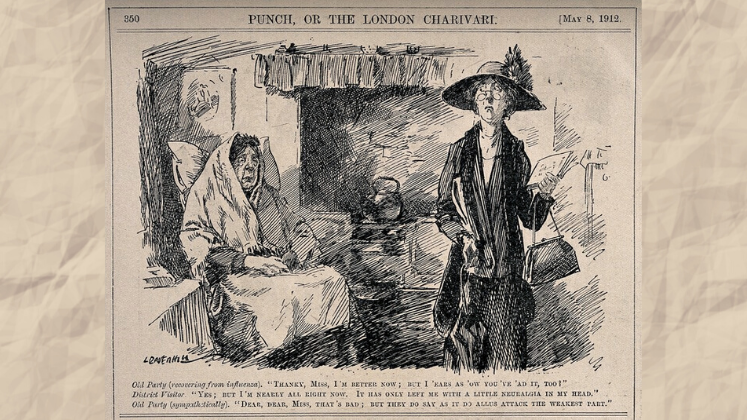
 In recent months, a number of high profile cases have focused attention on how credit is attributed to the creation of academic research and in particular the way in which the role of women is often diminished or effaced as part of this process. In this post Donica Belisle and Kiera Mitchell highlight the historical precedent of Mary Quayle Innis and the unrecognised impact she had on her husband Harold Adams Innis’ career and suggest that the social sciences and humanities would benefit from a wider interpretation of scholarly attribution than is currently practiced.
In recent months, a number of high profile cases have focused attention on how credit is attributed to the creation of academic research and in particular the way in which the role of women is often diminished or effaced as part of this process. In this post Donica Belisle and Kiera Mitchell highlight the historical precedent of Mary Quayle Innis and the unrecognised impact she had on her husband Harold Adams Innis’ career and suggest that the social sciences and humanities would benefit from a wider interpretation of scholarly attribution than is currently practiced.
In June 2019, journalist Anne Helen Petersen tweeted a screenshot of the Acknowledgements section of the book, Downsizing in America (New York: Russell Sage, 2003). In it, the book’s authors – William J. Baumol, Alan S. Blinder, and Edward N. Wolff – thank Sue Anne Batey Blackman for her contributions, stating that she was “a coauthor in all but name.” They also thank “Our secretaries … Janeece Lewis and Kathleen Hurley, [who] did their usual fine job of keeping track of the manuscript at many stages.” According to Petersen, such revelations are “WILD.” Respondents agreed, pointing to the unfairness of discrediting Blackman’s work as well as the rarity of secretarial assistance. All suggested that gender dynamics were at play. As Alejandra P. stated, “At least there isn’t any mention of an unnamed wife doing half the work.”
Such discussions indicate that there exists today both a familiarity with the older custom of senior academics taking credit for others’ work, and a strong distaste for the practice. Critics are quick to call out examples of uncredited research, such as they did in July 2019 when the US-based National Public Radio’s program “Here and Now” featured three male voices discussing – but not crediting – historian Sarah Milov’s recent research. These incidents reveal that definitions of authorship in the social sciences and humanities are changing, in the sense that it is now important to recognise all contributors. They also suggest that there is currently a sea change underway over a basic question in academe. Do female-identified scholars have academic authority? For while critics suggest that they certainly do, there also exists a long tradition of minimizing women’s academic work.
This tradition was particularly strong in the middle of the 20th century. Our study of the renowned Canadian academic couple, Mary Quayle Innis and Harold Adams Innis, reveals that it was common during this time for married scholars to work together as a team, but for the male spouse only to receive credit. This was due to a number of reasons, including the fact that it was usually the husband who had a formal position. Indeed, at the University of Toronto – where Innis worked – in 1941, women held only 64 of 492 faculty positions. Also contributing to women’s disempowerment was an association of research with masculinity. Saturated in reason and conviction, the male academic voice commanded respect. Equated with emotionality and domesticity, the female academic voice did not.
Many so-called “faculty wives” were aware of this disparity. In addition to publishing over 80 short stories, one novel, and several historical texts, Mary Quayle Innis (1899-1972) spent much of her life serving her husband’s career. She also kept detailed diaries of her efforts. Now available online, these works reveal the extent of her contributions. From their earliest days at the University of Chicago in 1919, where Quayle was Innis’s student, to their married life in Toronto, where Innis worked as Professor of Political Economy and Quayle raised their four children as well as built an independent career, Quayle worked on her husband’s projects. Her support included archival visits, library ventures, indexing, and taking notes. It included tabulating grades, preparing talks, and retrieving materials. It included writing, in the form of editing, explaining, finessing, and revising. And, it included typing. Quayle typed her husband’s dissertation and early books. After Innis died in 1952, she also typed up his lectures and field notes. These she deposited in Innis’s archives, which she helped curate, so that they could be accessed posthumously.
Those familiar with 20th century academe may be unsurprised by this history. But what is less recognised is the social labour that faculty wives performed. This, even more than wives’ intellectual contributions, built husbands’ careers. In 1923, for example, Quayle became active in the wives’ clubs at the University of Toronto, helping to form the Faculty Wives Association in 1936. By 1945 she had become President of the University Arts Women’s Club. In this capacity, she and her colleagues hosted dinners, raised funds, organised lectures, and awarded prizes. Quayle also attended most major academic social functions with her husband, thus enhancing his masculine status. Most significantly, Quayle hosted academic gatherings in her home. Almost every Saturday during the teaching terms, she baked and cleaned. Then, on Sundays, she and Innis welcomed academic guests, hosting events ranging from intimate student gatherings to large faculty celebrations. Through such work, she helped Innis enlarge his influence. She also furthered his research impact.
Today, as we consider the many labours that contribute to academic knowledge, we would do well to remember Mary Quayle Innis and her colleagues. Through their scholarly work, they facilitated research creation, publication, and dissemination. Through their nurturing labour, they created an atmosphere that enabled a privileged few to focus almost exclusively on their research. And, through their social efforts, they forged careers.
Certainly, we should not romanticise such endeavours. Faculty wives’ roles were born of a time in which most female-identified scholars could not achieve independence. Nonetheless, their contributions remain significant. They make visible the various types of work that go into creating academic prestige. They demonstrate the importance of caring labour for the production of quality research. Most of all, they remind us that many academics of previous generations built neither their ideas nor their reputations alone. Instead, they relied partially upon the contributions of unpaid spouses.
Faculty wives did not often receive formal credit for their work. Nevertheless, their social and scholarly labours helped construct the contemporary academy.
This post draws on the authors’ co-authored article, Mary Quayle Innis: Faculty Wives’ Contributions and the Making of Academic Celebrity, published in the Canadian Historical Review.
About the authors
Dr. Donica Belisle is an Associate Professor of History at the University of Regina in Saskatchewan, Canada. She researches the history of consumer culture – what and how we consume, and why we do so. This work is represented in her books, Purchasing Power: Women and the Rise of Canadian Consumer Culture (University of Toronto Press, 2019) and Retail Nation: Department Stores and the Making of Modern Canada (UBC Press 2011), as well as in numerous articles. Currently, she is writing a transnational history of Canadian sugar. Dr. Belisle has also written about gender and social privilege. Her recent article, co-authored with Kiera Mitchell, “Mary Quayle Innis: Faculty Wives’ Contributions and the Making of Academic Celebrity” examines masculinity, femininity, and stardom in academe. She can be found online at www.donicabelisle.com.
Kiera Mitchell is a Master’s student in History at the University of Saskatchewan in Saskatchewan, Canada. She is currently working on her thesis on the interconnected nature of feminist activism and feminist art in Western Canada. Kiera’s research interests are also reflected in works such as her recent article, co-authored with Dr. Donica Belisle, “Mary Quayle Innis: Faculty Wives’ Contributions and the Making of Academic Celebrity” which examines masculinity, femininity, and stardom in academe. She can be found online at bit.ly/kiera_mitchell.
Note: This article gives the personal view of the author, and not the position of the LSE Impact Blog, nor of the London School of Economics. Please review our comments policy if you have any concerns on posting a comment below
Featured Image Credit via Wikimedia Commons, (Public Domain).









This post by Donica Belisle & Kiera Mitchell with reference to the case of Mary Quayle Innis and Harold Adams Innis is a refreshing insight into gender inequality in scholarship and research in academic settings. It mirrors what pertains beyond the “ivory towers” and in corporate settings, where the contributions of females are minimized in knowledge management in general. The literature review of Bonnie Smith’s work on the gender inequality underpinning scholarship is very powerful. The concept of “ faculty wives’ roles and their contribution towards the production of academic work and prestige is another reminder that SDG 5(gender equality), 10(reduced inequalities) equally applies to academia and industry and there is need for leadership intentionality to focus on them in a sustainable manner. For me as an HR practitioner & researcher, this post is very revealing and I applaud the authors for this brilliant work.